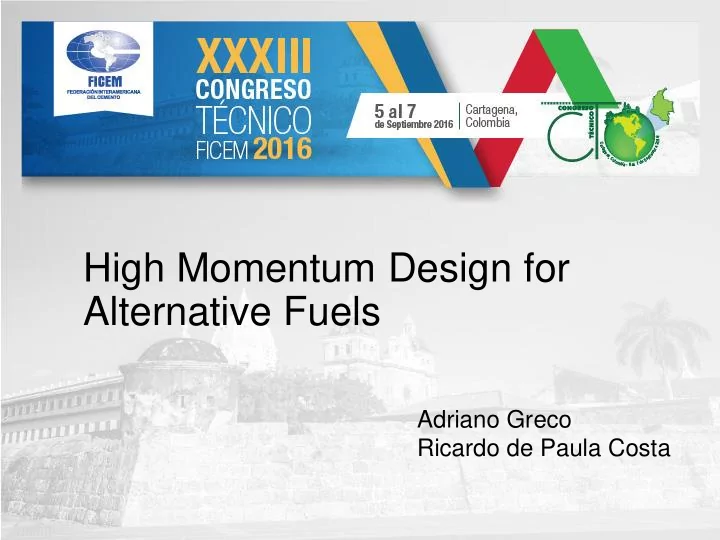

High Momentum Design for Alternative Fuels Adriano Greco Ricardo de Paula Costa
Alternative Fuels Benefits • Cement plant point of view • Cheaper kiln fuel resource • Lower NOx emission • Wastes elimination point of view (comparing to other elimination methods) • Utilize its heat capacity • Full destruction of the material • Do not have ashes (incorporated to the clinker)
Worldwide tr trend Austria: >70% 2015 Germany: >60% 3
Alternative Fuels – Latin America Latin America: < 20%
Alternative Fuels used at at Cement In Industry • Animal Meal • Shreaded Plastics • Wood chips • Saw dust • Biomass – husks • Tires chips • Fluff – municipal waste • Chicken feathers • Glycerin • Textiles • Solvents • Sewage sludge • Oil Sludge • Cellulose, paper, board
Fir iring Alt lternatives Fuels • Modern Kilns • Start using calciner for AF firing • Bigger particles sizes of AF • High Substitution – Main Burner • Old Kilns – No calciners • Main burner • Mid kiln tires firing • Small portion in the kiln back
Alternative Fuels Sel electio ion To be considered when firing AF: - AF preparation - Constant feed / conveying - Chemical analysis - C, H, O, N, S, Cl - Moisture, Volatiles - Flame adiabatic temperature - Refractory infiltration - Sulfur balance - Cl balance - Presence of heavy metals P, Hg, Ti ... - Lower clinker production (O2 and H2O) - Maximum and Minimum particle dimension - Shape of the particle
Combustion of of Soli lid Was astes Overvi rview Importance of particle shape: COMBUSTION: area of sphere with the same volume sphericity area of real particle C L A Superficial Particle Equivalent area (mm 2 ) (mm) (mm) (mm) volume sphere area (mm 3 ) (mm 2 ) I 1.0 5.0 10.0 130.0 50.0 65.6 0.50 II 3.0 3.0 5.5 84.0 49.5 65.2 0.78 • Particles with lower sphericity have more surface area for the same volume, i.e. they tend to present better heat and mass tranfer Particles with lower sphericity have lower terminal velocity, thus they have • higher “flying” time
Fir iring Alt lternatives Fuels When higher substitution rates are attempted with inadequate technology: • Unstable flame • Wrong kiln thermal profile • Higher kiln inlet temperatures • Fuel falling onto clinker bed • Reduction zone near clinker • Excessive Sulphur recirculation • Rings formation • CO emissions • Clinker quality • Cement Strength • Operational problems • Environmental problems
Burners development Old Concept New Concept One or more pipes above One or more pipes inside the burner the burner • • High oxygen zone Low oxygen zone • • Low control High control • • Low mixing High mixing
Hig igh Momentum Burner Advantages of High flame momentum : • Kiln operations becomes more stable & improved fuel efficiency for hard to burn fuels • Improved clinker reactivity and shorter sintering zone • Lowered volatility and recirculation of sulfur in kiln gases (control of surfur into the clinker) • Tendency for ring formation is lower • Clinker granulometry more uniform Requirement: • Quick mixing of secondary air to the flame, to allow the complete combustion which is iniciated by primary air. • Primary air jets need to accellerate the secondary air. • Internal recirculations are controlling the ignition distance of the fuel
Combustion SECONDARY AIR • High oxygen availability: 95-100% of required amount • Low control and mixing • Low velocity Secondary Air Primary Air Secondary Air Recirculated PRIMARY AIR • Low oxygen availability: 8-12% of Combustion required amount Gases • High control and mixing • Ignition fuel zone • Flame stability
Burner Concept Axial Air Coal / Petcoke Swirl Air Alternative Flame Scanner Fuels Lofting Air Igniter supply Natural Gas RDF Pipe – easily removable Alternative Fuels • Primary air pressure – 250 up to 650 mbar(g) With Lofting Air • Minimum coal/petcoke transport air - up to 5,0 kg/kg of air • 8 to 12% of stoichiometric combustion air • AF (solids) – with Lofting air • Easy to burn AF – up to 4,0 kg/kg of air • Hard to burn AF – up to 2,5 kg/kg of air
Axi xial l Air ir Mixing of the fuel and air occurs primarily as a result of jet entrainment U Nozzle Uo Um r do Mixing Transition Potential Core Region Region A free jet can entrain as much of the surrounding air until it’s velocity is the same as its surroundings and thus is able to expand unimpeded • • • • • • •
Axi xial l Air ir
Loft fting Air ir Air Assisted Dispersion of RDF and other similar fuels Lofting Air supply Lofting air RDF Pipe – easily solid dispersion removable pattern
Loft fting Air ir Effect of lofting air on volatiles burnout - The effect of lofting air on flame RDF temperature map RDF volatiles mass Flame fraction (coloured temperature regions show RDF concentration) Lofting air OFF Lofting air OFF Burner tip Lofting air ON Lofting air ON
Loft fting Air ir
Conclusion • High Alternative Fuels Substitution requires a burner with high momentum and good design in order to provide: • Better mixture between secondary air and fuel; • Better control of the flame envelope; • Fast interation between the AF and O2; • Good thermal flux. Thank You
Recommend
More recommend